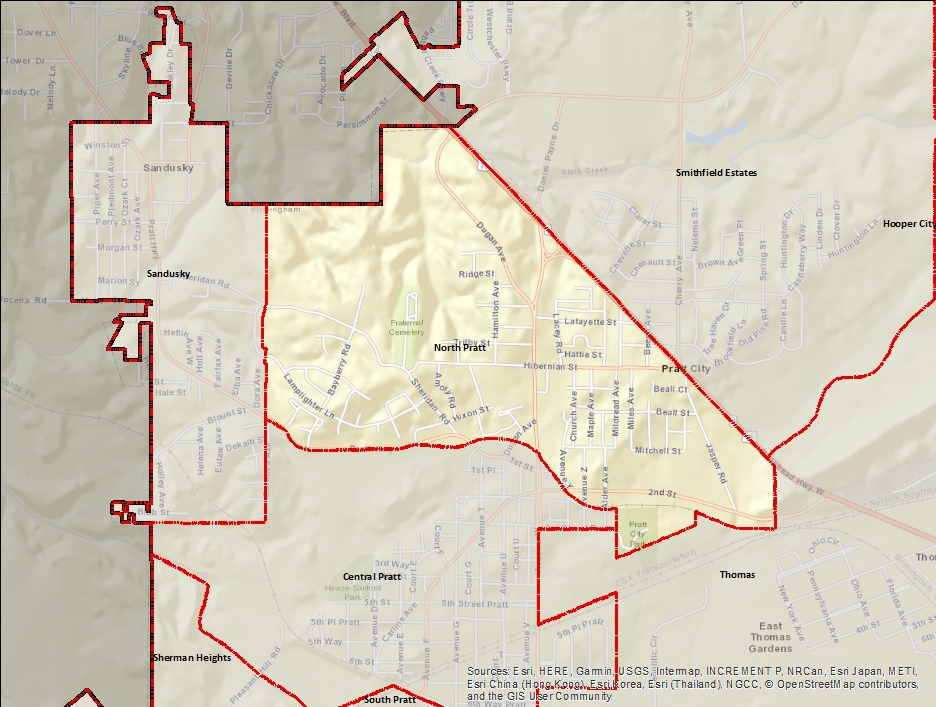North Pratt
North Pratt is part of the Pratt community, formerly Pratt City founded in the late 1800s. The area, originally called Coketon, grew up rapidly around the Pratt Mines, which had opened in the early 1870s and expanded to become the state's largest mine complex by 1886. Pratt CIty was annexed into Birmingham in 1910. The Pratt Mines ceased operating in the 1920s, though the community remained a commercial destination until the 1950s.
Indicator Details
| Indicators |
Primary Domain |
Indicator Value | Rank | Tier | Indicator Weight |
|---|---|---|---|---|---|
| Business Retention | Economic Health | 11.8% | 15 | Top | 1.00 |
| Access to Mainstream Financial Services | Economic Health | 30.3% | 55 | Middle | 1.00 |
| Local Business Vitality | Economic Health | 68.4% | 26 | Top | 1.00 |
| Payday Loans | Economic Health | 2 | 82 | Bottom | 1.00 |
| Reading Proficiency | Educational Opportunities | 10.5% | 57 | Middle | 3.00 |
| Adult Educational Attainment | Educational Opportunities | 77.4% | 53 | Middle | 3.00 |
| High School Graduation Rate | Educational Opportunities | 75.8% | 65 | Middle | 3.00 |
| School Readiness Scores | Educational Opportunities | -% | - | Data N/A | 1.00 |
| Preschool Enrollment | Educational Opportunities | 92.8% | 2 | Top | 3.00 |
| Residential Proximity to Traffic | Environmental Hazards | 0.4% | 64 | Middle | 1.00 |
| Proximity to Brownfield Sites | Environmental Hazards | 0.0% | 1 | Top | 1.00 |
| School Proximity to Traffic | Environmental Hazards | 0.0% | 1 | Top | 1.00 |
| Proximity to Superfund Sites | Environmental Hazards | 0.3% | 54 | Middle | 1.00 |
| Toxic Releases from Facilities | Environmental Hazards | 54.2% | 27 | Top | 1.00 |
| Public Assisted Households | Employment Opportunities | 62.2% | 76 | Bottom | 1.00 |
| Employment Rate | Employment Opportunities | 85.3% | 45 | Middle | 1.00 |
| Long-Term Unemployment | Employment Opportunities | 0.8% | 3 | Top | 1.00 |
| Travel Time to Work | Employment Opportunities | 26.7 | 75 | Bottom | 1.00 |
| Vacancy Rates | Housing | 24.4% | 69 | Bottom | 1.00 |
| Age of Housing | Housing | 51.5% | 6 | Top | 1.00 |
| Blood Lead Levels in Children | Housing | -% | - | Data N/A | 1.00 |
| Excessive Housing Cost Burden | Housing | 36.8% | 36 | Middle | 1.00 |
| Pedestrian & Bicycle Injuries by Motor Vehicles | Health Systems and Public Safety | 0 | 1 | Top | 4.00 |
| Public Health Nuisances | Health Systems and Public Safety | 73.8 | 55 | Middle | 4.00 |
| Infant Mortality Rate | Health Systems and Public Safety | 11.7 | 36 | Middle | 1.00 |
| Violent Crime | Health Systems and Public Safety | 71.3 | 29 | Top | 4.00 |
| Chronic School Absence | Health Systems and Public Safety | 31.0% | 75 | Bottom | 1.00 |
| Low Birth Weight | Health Systems and Public Safety | -% | - | Data N/A | 1.00 |
| Motor Vehicle Collisions | Health Systems and Public Safety | 5.4 | 50 | Middle | 4.00 |
| Preventable Hospitalizations | Health Systems and Public Safety | - | - | Data N/A | 1.00 |
| Tree Cover | Natural Areas | 32.0% | 18 | Top | 1.00 |
| Access to Parks and Open Space | Natural Areas | 75.5% | 73 | Bottom | 1.00 |
| Walkability | Neighborhood Characteristics | 52.3 | 49 | Middle | 4.00 |
| Land Use Mix | Neighborhood Characteristics | 0.6 | 39 | Middle | 1.00 |
| Offsite Alcohol Outlets | Neighborhood Characteristics | 0.5 | 50 | Middle | 1.00 |
| Food Desert | Neighborhood Characteristics | 85.7% | 52 | Middle | 2.00 |
| Residential Mobility | Social Cohesion | 93.4% | 11 | Top | 1.00 |
| Voter Participation | Social Cohesion | 5.4% | 49 | Middle | 1.00 |
| Transit Accessibility | Transportation | 4.5 | 55 | Middle | 4.00 |
| Commute Mode Share | Transportation | 8.5% | 86 | Bottom | 4.00 |
| Household Transportation Costs | Transportation | 26.1% | 67 | Bottom | 4.00 |
| Pedestrian Connectivity | Transportation | 81 | 59 | Middle | 4.00 |
| Abandoned Structures | Blight | 12.2% | 59 | Middle | 5.00 |
| Tax Delinquent Properties | Blight | 18.7% | 48 | Middle | 5.00 |
| Visual Property Nuisances | Blight | 17.6% | 60 | Middle | 5.00 |

Demographic and Contextual Indicators
| Neighborhood | City Wide | |
|---|---|---|
| Income Inequality | 0.4 | 0.49 |
| Concentrated Poverty | 17.1% | 30.9% |
| Life Expectancy | 71.4 | 78.8 |
| Population | 2,032 | 210,616 |
| Racial and Ethnic Diversity | 0.1 | 0.44 |
| Park Quality | 70.8 |